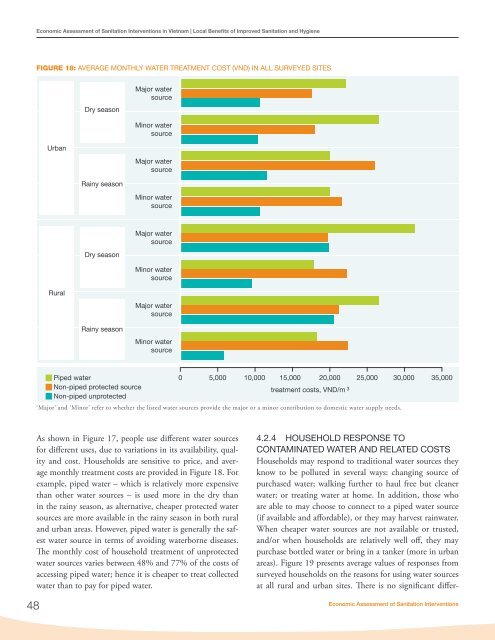Economic Assessment of Sanitation Interventions in Vietnam - WSP
Economic Assessment of Sanitation Interventions in Vietnam - WSP
Economic Assessment of Sanitation Interventions in Vietnam - WSP
You also want an ePaper? Increase the reach of your titles
YUMPU automatically turns print PDFs into web optimized ePapers that Google loves.
<strong>Economic</strong> <strong>Assessment</strong> <strong>of</strong> <strong>Sanitation</strong> <strong>Interventions</strong> <strong>in</strong> <strong>Vietnam</strong> | Local Benefits <strong>of</strong> Improved <strong>Sanitation</strong> and HygieneFIGURE 18: AVERAGE MONTHLY WATER TREATMENT COST (VND) IN ALL SURVEYED SITESDry seasonMajor watersourceM<strong>in</strong>or watersourceUrbanMajor watersourceRa<strong>in</strong>y seasonM<strong>in</strong>or watersourceMajor watersourceDry seasonM<strong>in</strong>or watersourceRuralMajor watersourceRa<strong>in</strong>y seasonM<strong>in</strong>or watersourcePiped water0 5,000 10,000 15,000 20,000 25,000 30,000 35,000Non-piped protected sourcetreatment costs, VND/m 3Non-piped unprotected‘Major’ and ‘M<strong>in</strong>or’ refer to whether the listed water sources provide the major or a m<strong>in</strong>or contribution to domestic water supply needs.48As shown <strong>in</strong> Figure 17, people use different water sourcesfor different uses, due to variations <strong>in</strong> its availability, qualityand cost. Households are sensitive to price, and averagemonthly treatment costs are provided <strong>in</strong> Figure 18. Forexample, piped water – which is relatively more expensivethan other water sources – is used more <strong>in</strong> the dry than<strong>in</strong> the ra<strong>in</strong>y season, as alternative, cheaper protected watersources are more available <strong>in</strong> the ra<strong>in</strong>y season <strong>in</strong> both ruraland urban areas. However, piped water is generally the safestwater source <strong>in</strong> terms <strong>of</strong> avoid<strong>in</strong>g waterborne diseases.The monthly cost <strong>of</strong> household treatment <strong>of</strong> unprotectedwater sources varies between 48% and 77% <strong>of</strong> the costs <strong>of</strong>access<strong>in</strong>g piped water; hence it is cheaper to treat collectedwater than to pay for piped water.4.2.4 HOUSEHOLD RESPONSE TOCONTAMINATED WATER AND RELATED COSTSHouseholds may respond to traditional water sources theyknow to be polluted <strong>in</strong> several ways: chang<strong>in</strong>g source <strong>of</strong>purchased water; walk<strong>in</strong>g further to haul free but cleanerwater; or treat<strong>in</strong>g water at home. In addition, those whoare able to may choose to connect to a piped water source(if available and affordable), or they may harvest ra<strong>in</strong>water.When cheaper water sources are not available or trusted,and/or when households are relatively well <strong>of</strong>f, they maypurchase bottled water or br<strong>in</strong>g <strong>in</strong> a tanker (more <strong>in</strong> urbanareas). Figure 19 presents average values <strong>of</strong> responses fromsurveyed households on the reasons for us<strong>in</strong>g water sourcesat all rural and urban sites. There is no significant differ-<strong>Economic</strong> <strong>Assessment</strong> <strong>of</strong> <strong>Sanitation</strong> <strong>Interventions</strong>
















